Evaluation of the Performance of the Horizontal Drain in Drainage of the Infiltrated Water from Slope Soil under Rainfall Conditions
Abstract
1. Introduction
2. Design of Horizontal Drain
3. Numerical Modeling
3.1. Model Assumptions
3.2. Geometry and Boundary Conditions
- (a)
- Surface Boundary: The surface boundary includes the slope surface, which is designated as the rainfall boundary. This is where precipitation will pervade the soil, simulating the natural process of rainfall infiltration.
- (b)
- Rest of the Boundary: The remaining boundaries, specifically the bottom and the side of the model, are set to impermeable conditions. This means that water cannot permeate through these boundaries.
3.3. Constitutive Models and Material Properties
3.4. Numerical Simulation Scenarios
- (a)
- Impact of Drain Length: This plan varies the length of the horizontal drain to analyze its effect on drainage. Drain lengths of 4 m, 7 m, 10 m, and 15 m were examined.
- (b)
- Impact of Drain Inclination Angle: This plan alters the inclination angle of the horizontal drain to assess its influence on drainage. Drain inclination angles of 5°, 10°, and 15° were considered.
- (c)
- Impact of Drain Placement Position: This plan modifies the placement position of the horizontal drain to evaluate its impact on drainage. Drain positions in the middle and lower parts of the slope were tested.
4. Results and Discussions
4.1. Selection of the Sections for the Monitoring of the Distribution of Pore-Water Pressure
4.2. The Distribution of the Pore-Water Pressure under Rainfall Conditions
4.3. Effect of the Pipe Length on the Performance of Discharging the Infiltrated Water
4.4. Effect of the Pipe Inclination on the Performance of Discharging the Infiltrated Water
4.5. Effect of the Position of the Pipe on the Performance of Discharging the Infiltrated Water
5. Conclusions
Author Contributions
Funding
Institutional Review Board Statement
Informed Consent Statement
Data Availability Statement
Conflicts of Interest
References
- Collins, B.D.; Znidarcic, D. Stability Analyses of Rainfall Induced Landslides. J. Geotech. Geoenvironmental Eng. 2004, 130, 362–372. [Google Scholar] [CrossRef]
- Oh, S.; Lu, N. Slope Stability Analysis under Unsaturated Conditions: Case Studies of Rainfall-Induced Failure of Cut Slopes. Eng. Geol. 2015, 184, 96–103. [Google Scholar] [CrossRef]
- Cho, S.E.; Lee, S.R. Instability of Unsaturated Soil Slopes Due to Infiltration. Comput. Geotech. 2001, 28, 185–208. [Google Scholar] [CrossRef]
- Kim, J.; Jeong, S.; Park, S.; Sharma, J. Influence of Rainfall-Induced Wetting on the Stability of Slopes in Weathered Soils. Eng. Geol. 2004, 75, 251–262. [Google Scholar] [CrossRef]
- Leroueil, S. Natural Slopes and Cuts: Movement and Failure Mechanisms. Géotechnique 2001, 51, 197–243. [Google Scholar] [CrossRef]
- Dai, F.C.; Lee, C.F. Frequency-Volume Relation and Prediction of Rainfall-Induced Landslides. Eng. Geol. 2001, 59, 253–266. [Google Scholar] [CrossRef]
- Tsaparas, I.; Rahardjo, H.; Toll, D.G.; Leong, E.C. Controlling Parameters for Rainfall-Induced Landslides. Comput. Geotech. 2002, 29, 1–27. [Google Scholar] [CrossRef]
- Ng, C.W.W.; Shi, Q. A Numerical Investigation of the Stability of Unsaturated Soil Slopes Subjected to Transient Seepage. Comput. Geotech. 1998, 22, 1–28. [Google Scholar] [CrossRef]
- Zhang, L.L.; Zhang, J.; Zhang, L.M.; Tang, W.H. Stability Analysis of Rainfall-Induced Slope Failure: A Review. Proc. Inst. Civ. Eng.—Geotech. Eng. 2011, 164, 299–316. [Google Scholar] [CrossRef]
- Robinson, J.D.; Vahedifard, F.; AghaKouchak, A. Rainfall-Triggered Slope Instabilities under a Changing Climate: Comparative Study Using Historical and Projected Precipitation Extremes. Can. Geotech. J. 2017, 54, 117–127. [Google Scholar] [CrossRef]
- Greenwood, J.R.; Norris, J.E.; Wint, J. Assessing the Contribution of Vegetation to Slope Stability. Proc. Inst. Civ. Eng.—Geotech. Eng. 2004, 157, 199–207. [Google Scholar] [CrossRef]
- Won, J.; You, K.; Jeong, S.; Kim, S. Coupled Effects in Stability Analysis of Pile–Slope Systems. Comput. Geotech. 2005, 32, 304–315. [Google Scholar] [CrossRef]
- Reubens, B.; Poesen, J.; Danjon, F.; Geudens, G.; Muys, B. The Role of Fine and Coarse Roots in Shallow Slope Stability and Soil Erosion Control with a Focus on Root System Architecture: A Review. Trees 2007, 21, 385–402. [Google Scholar] [CrossRef]
- Royster, D.L. Horizontal Drains and Horizontal Drilling: An Overview. Transp. Res. Rec. 1980, 783, 16–20. [Google Scholar]
- Rahardjo, H.; Hritzuk, K.J.; Leong, E.C.; Rezaur, R.B. Effectiveness of Horizontal Drains for Slope Stability. Eng. Geol. 2003, 69, 295–308. [Google Scholar] [CrossRef]
- Cai, F.; Ugai, K.; Wakai, A.; Li, Q. Effects of Horizontal Drains on Slope Stability under Rainfall by Three-Dimensional Finite Element Analysis. Comput. Geotech. 1998, 23, 255–275. [Google Scholar] [CrossRef]
- Nagahara, H.; Fujiyama, T.; Ishiguro, T.; Ohta, H. FEM Analysis of High Airport Embankment with Horizontal Drains. Geotext. Geomembr. 2004, 22, 49–62. [Google Scholar] [CrossRef]
- Rahardjo, H.; Santoso, V.A.; Leong, E.C.; Ng, Y.S.; Hua, C.J. Performance of Horizontal Drains in Residual Soil Slopes. Soils Found. 2011, 51, 437–447. [Google Scholar] [CrossRef]
- Argunhan-Atalay, C.; Yazicigil, H.; Ekmekci, M. Assessment of Performance of Horizontal Drains in an Open Pit Mine in Eastern Turkey. Environ. Earth Sci. 2021, 80, 108. [Google Scholar] [CrossRef]
- Lakruwan, M.; Oikawa, H.; Kamura, A.; Kazama, M. Experimental Evaluation of Effect of Perforation Arrangement on Performance of Horizontal Drains in Landslide Mitigation. Landslides 2021, 18, 3707–3714. [Google Scholar] [CrossRef]
- Cook, D.I.; Santi, P.M.; Higgins, J.D. 2007 AEG Student Professional Paper: Graduate Division: Horizontal Landslide Drain Design: State of the Art and Suggested Improvements. Environ. Eng. Geosci. 2008, 14, 241–250. [Google Scholar] [CrossRef]
- Forrester, K. Subsurface Drainage for Slope Stabilization; American Society of Civil Engineers: Reston, VA, USA, 2001; ISBN 978-0-7844-0016-6. [Google Scholar]
- Fall, M.; Azzam, R.; Noubactep, C. A Multi-Method Approach to Study the Stability of Natural Slopes and Landslide Susceptibility Mapping. Eng. Geol. 2006, 82, 241–263. [Google Scholar] [CrossRef]
- Cook, D.I.; Santi, P.M.; Higgins, J.D. Prediction of Piezometric Surfaces and Drain Spacing for Horizontal Drain Design. Landslides 2012, 9, 547–556. [Google Scholar] [CrossRef]
- Sari, P.T.K. The Performance of Horizontal Drain as a Landslide Mitigation Strategy. In Proceedings of the 5th International Conference on Rehabilitation and Maintenance in Civil Engineering, ICRMCE 2021, Surakarta, Indonesia, 8–9 July 2021; Kristiawan, S.A., Gan, B.S., Shahin, M., Sharma, A., Eds.; Springer Nature: Singapore, 2023; pp. 449–456. [Google Scholar]
- Cuomo, S.; Della Sala, M. Rainfall-Induced Infiltration, Runoff and Failure in Steep Unsaturated Shallow Soil Deposits. Eng. Geol. 2013, 162, 118–127. [Google Scholar] [CrossRef]
- Rahardjo, H.; Santoso, V.A.; Leong, E.C.; Ng, Y.S.; Hua, C.J. Numerical Analyses and Monitoring Performance of Residual Soil Slopes. Soils Found. 2011, 51, 471–482. [Google Scholar] [CrossRef][Green Version]
- Rahimi, A.; Rahardjo, H.; Leong, E.-C. Effect of Antecedent Rainfall Patterns on Rainfall-Induced Slope Failure. J. Geotech. Geoenvironmental Eng. 2011, 137, 483–491. [Google Scholar] [CrossRef]
- GEO-SLOPE International Ltd. Seepage Modeling with SEEP/W; An Engineering Methodology June 2015 ed.; GEO-SLOPE International Ltd.: Calgary, AB, Canada, 2015. [Google Scholar]
- Liu, Y.; Tian, G.; Wang, S.; Satyanaga, A.; Zhai, Q. Parametric Analysis of Rainfall-Induced Loess Soil Slope Due to the Rainwater Infiltration. Urban Sci. 2022, 6, 54. [Google Scholar] [CrossRef]
- Zhai, Q.; Rahardjo, H. Determination of Soil–Water Characteristic Curve Variables. Comput. Geotech. 2012, 42, 37–43. [Google Scholar] [CrossRef]
- Fredlund, D.G.; Xing, A.; Huang, S. Predicting the Permeability Function for Unsaturated Soils Using the Soil-Water Characteristic Curve. Can. Geotech. J. 1994, 31, 533–546. [Google Scholar] [CrossRef]
- Santi, P.M.; Dale Elifrits, C.; Liljegren, J.A. Design and Installation of Horizontal Wick Drains for Landslide Stabilization. Transp. Res. Rec. 2001, 1757, 58–66. [Google Scholar] [CrossRef]

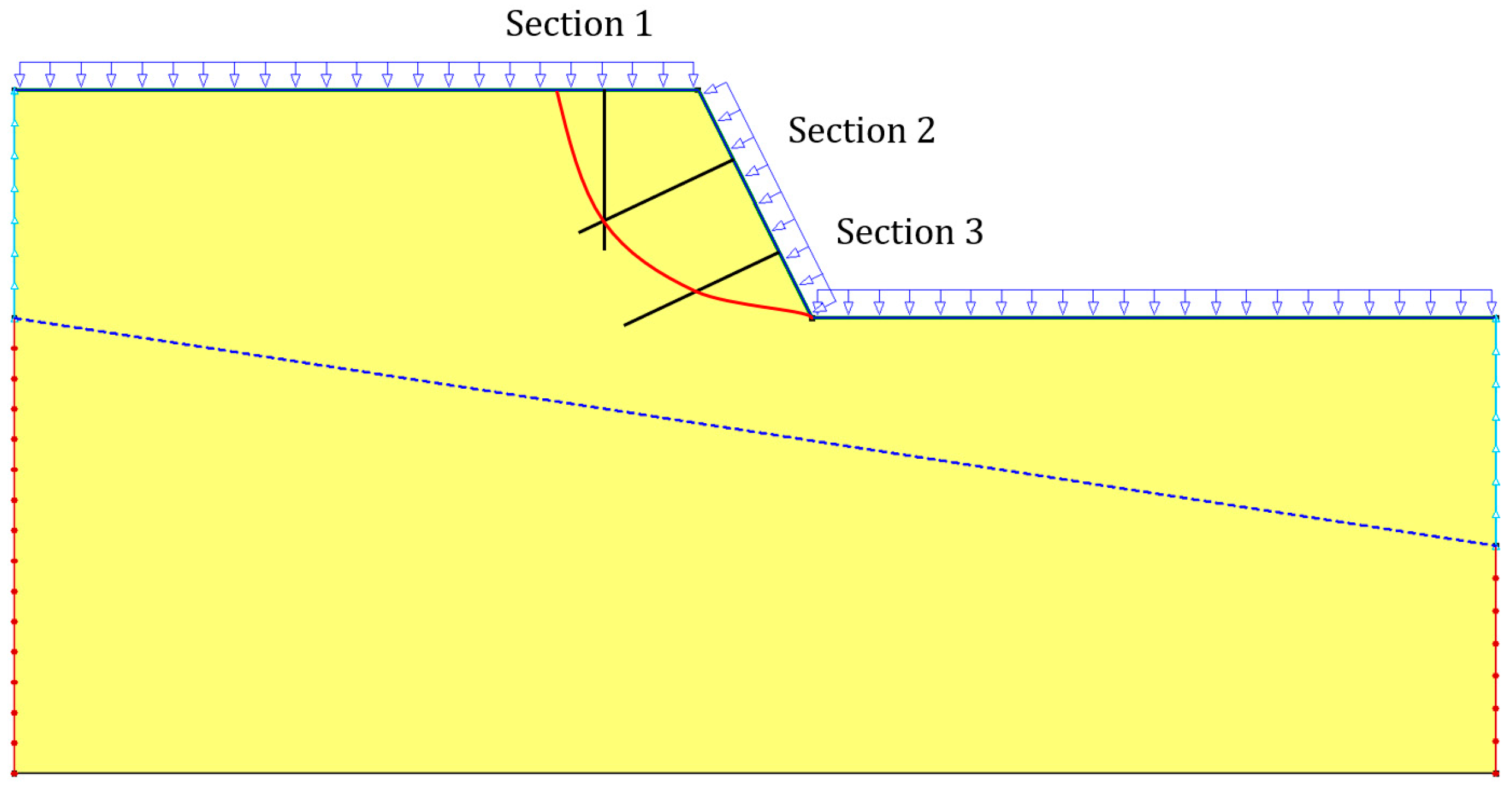
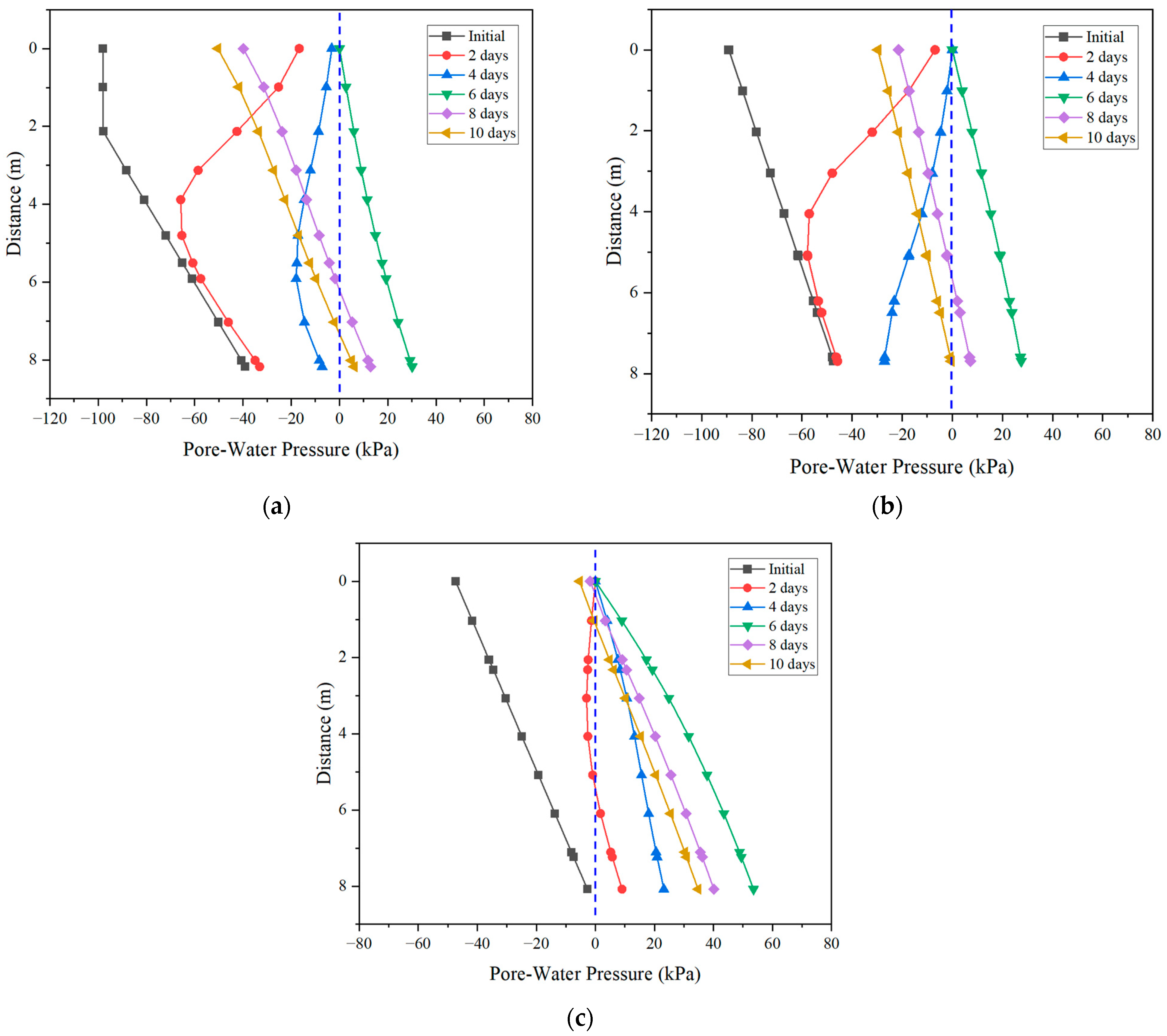
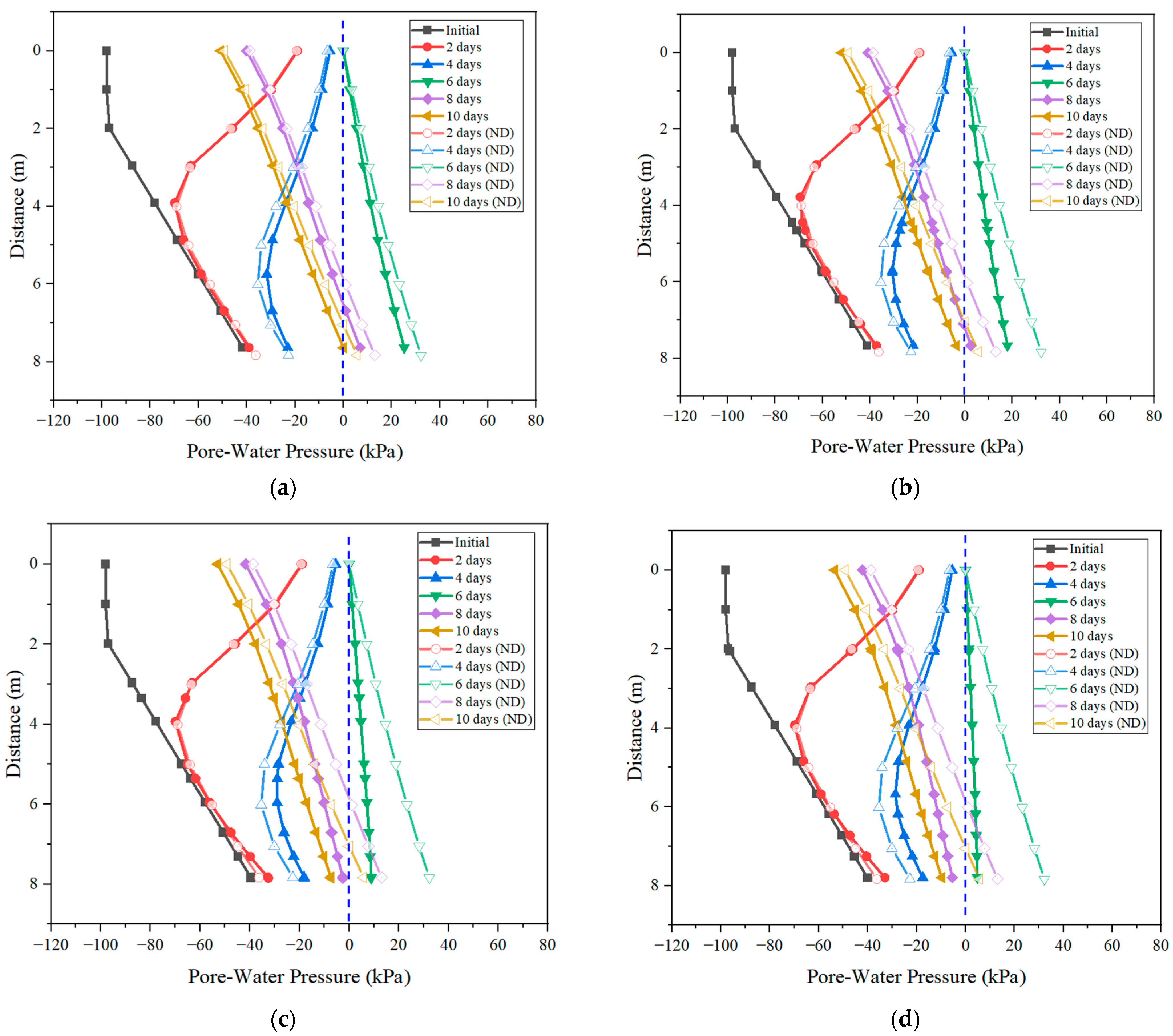
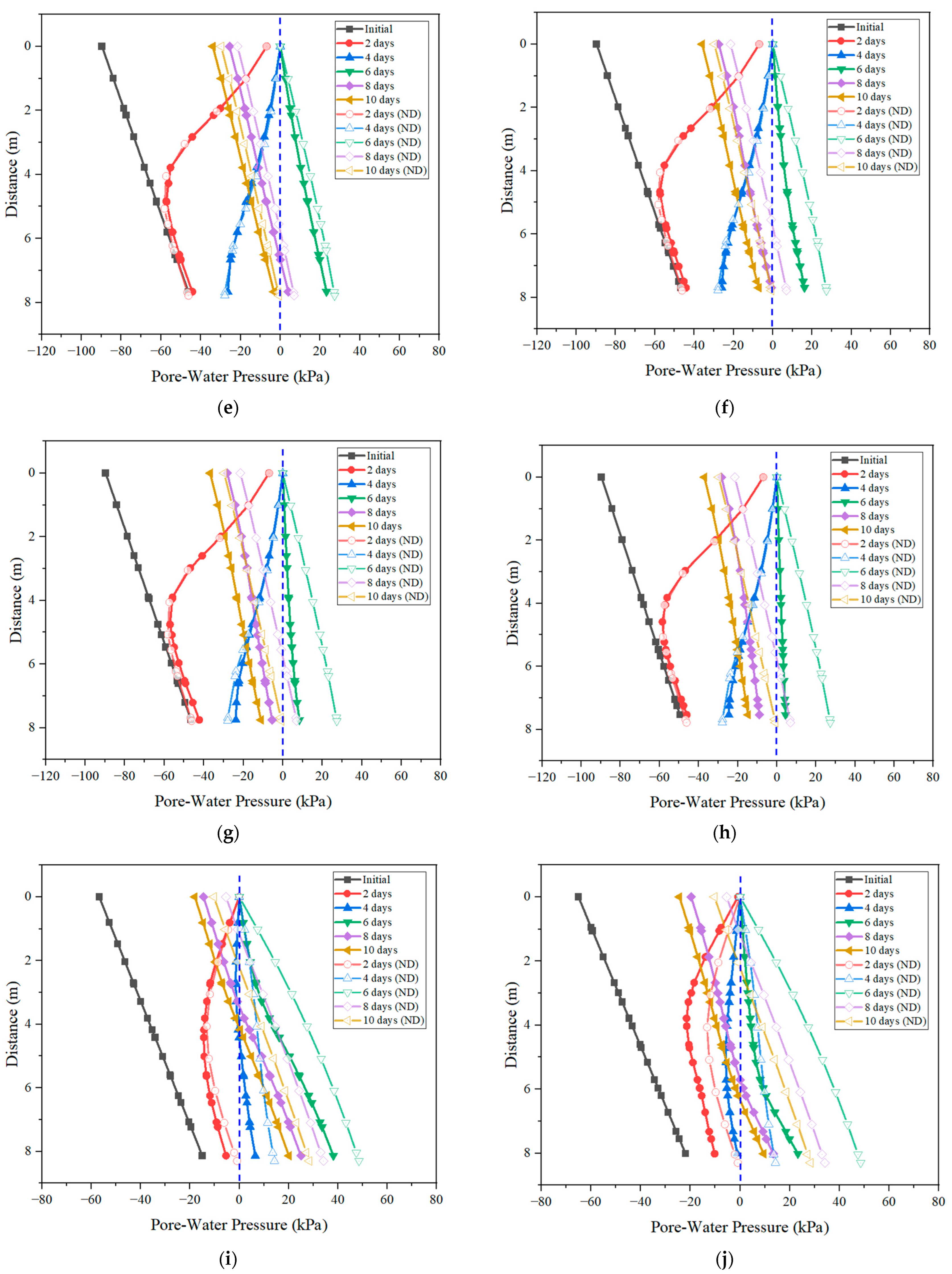
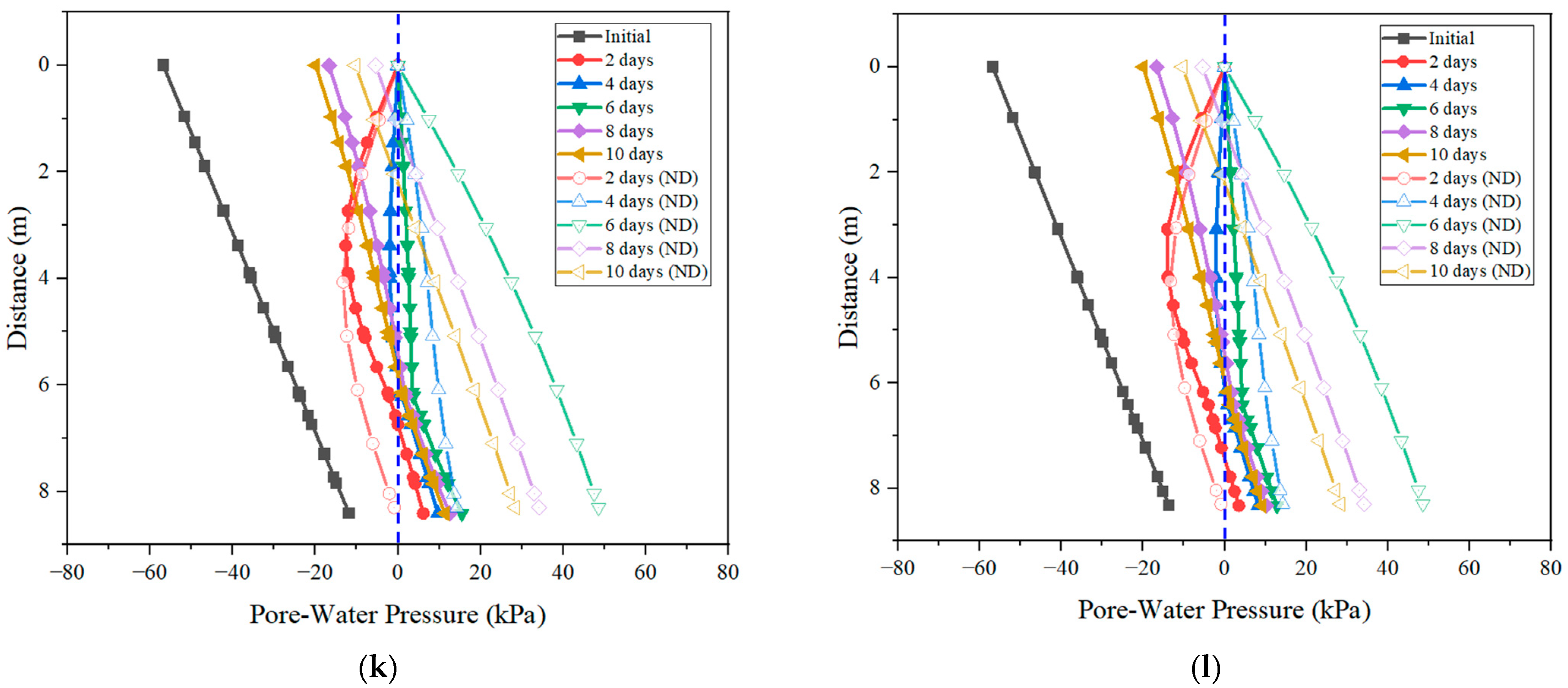
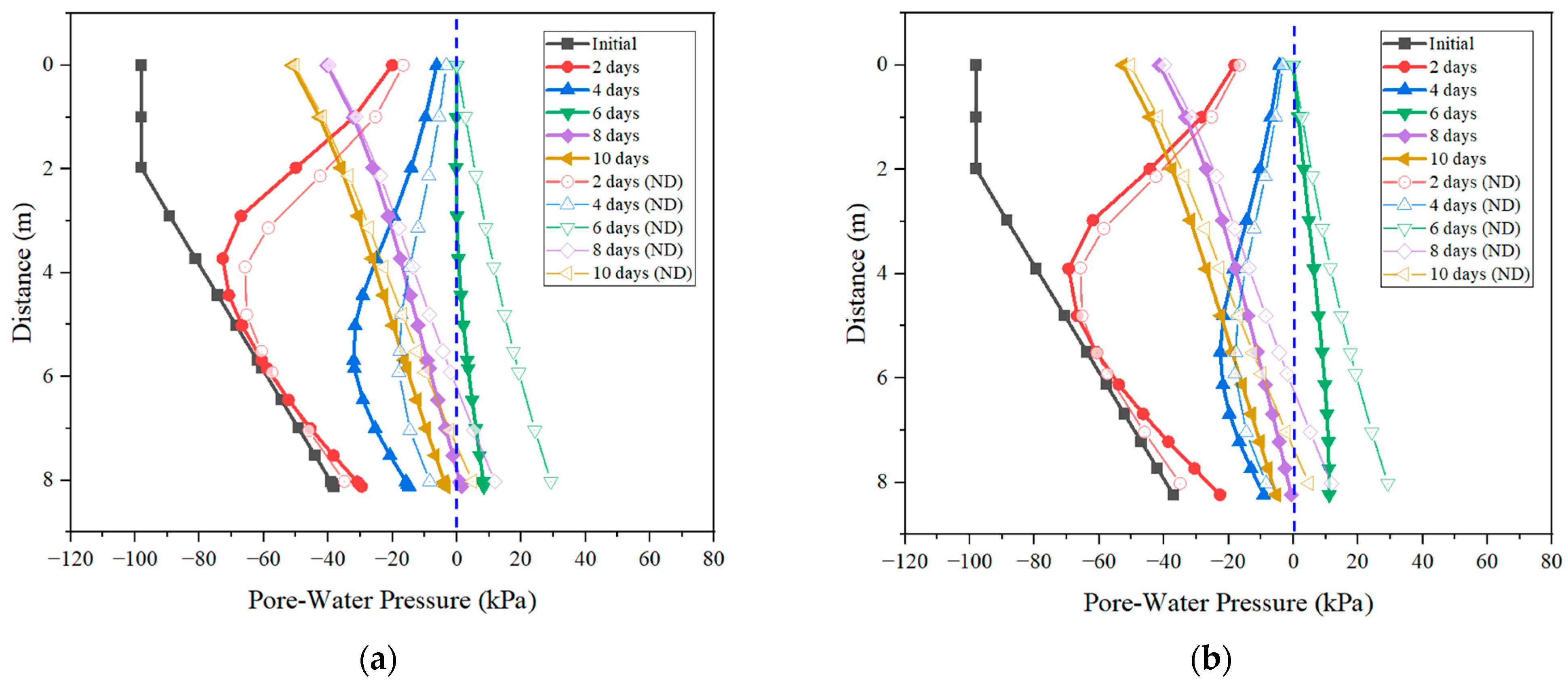
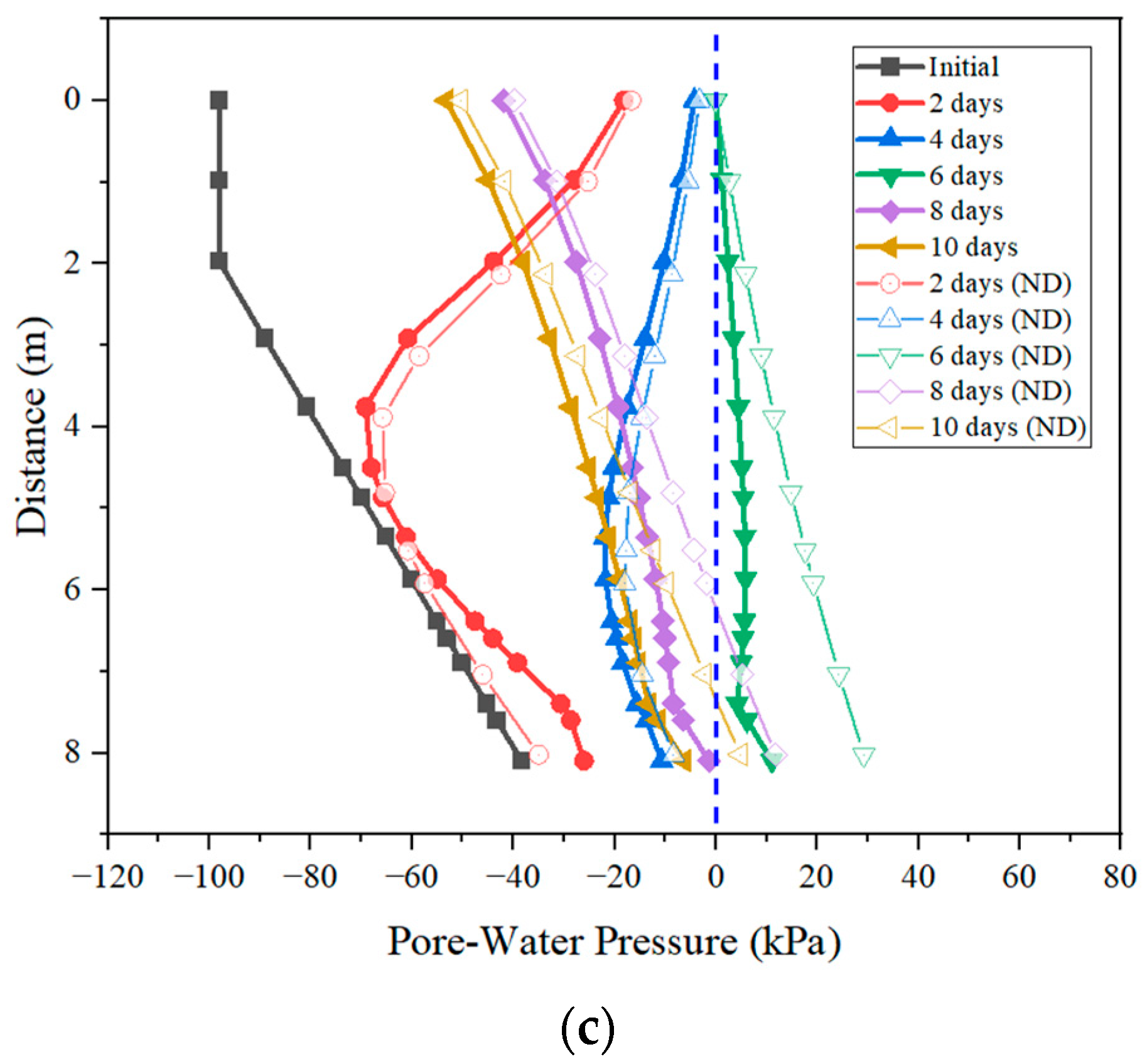
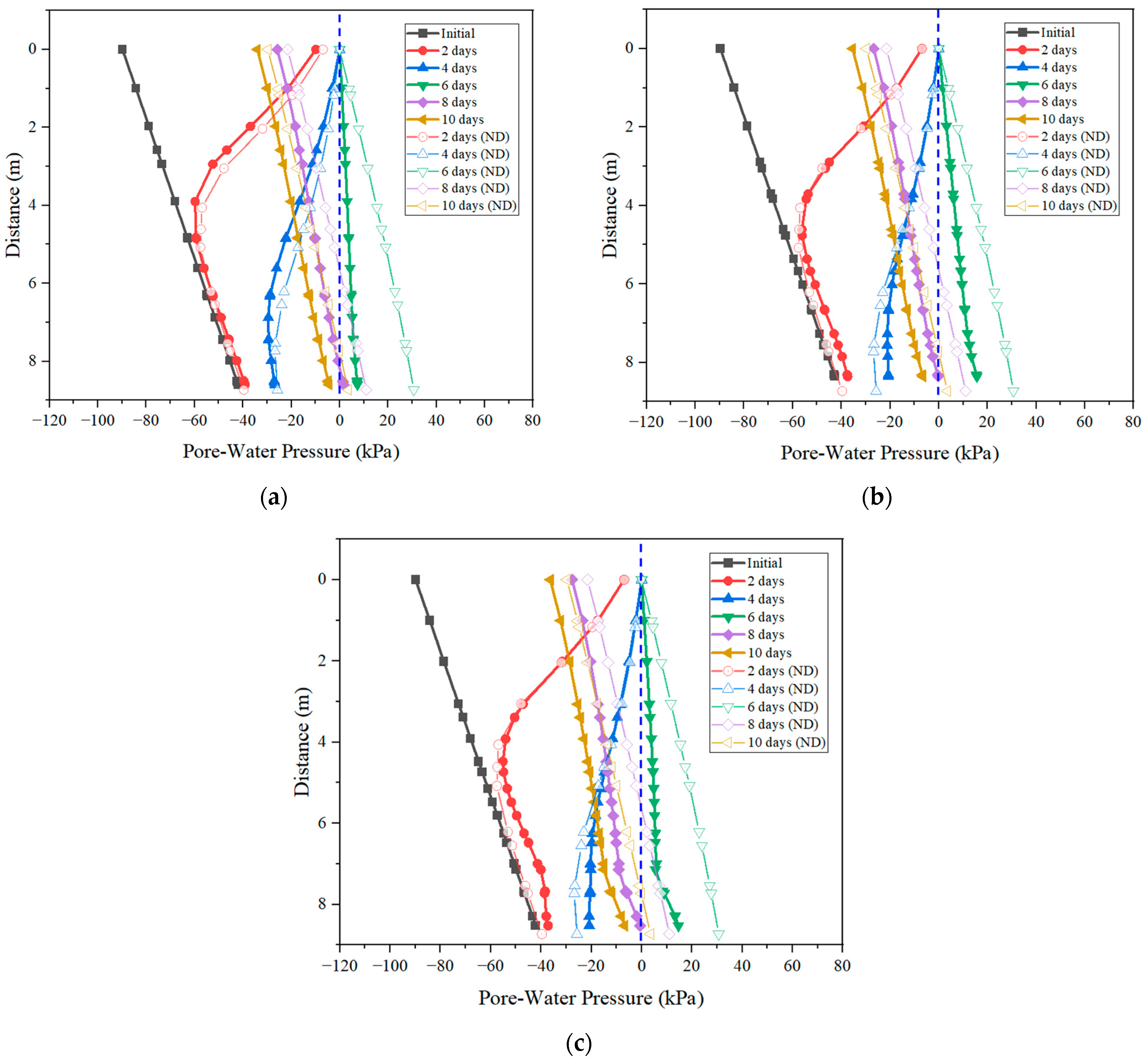
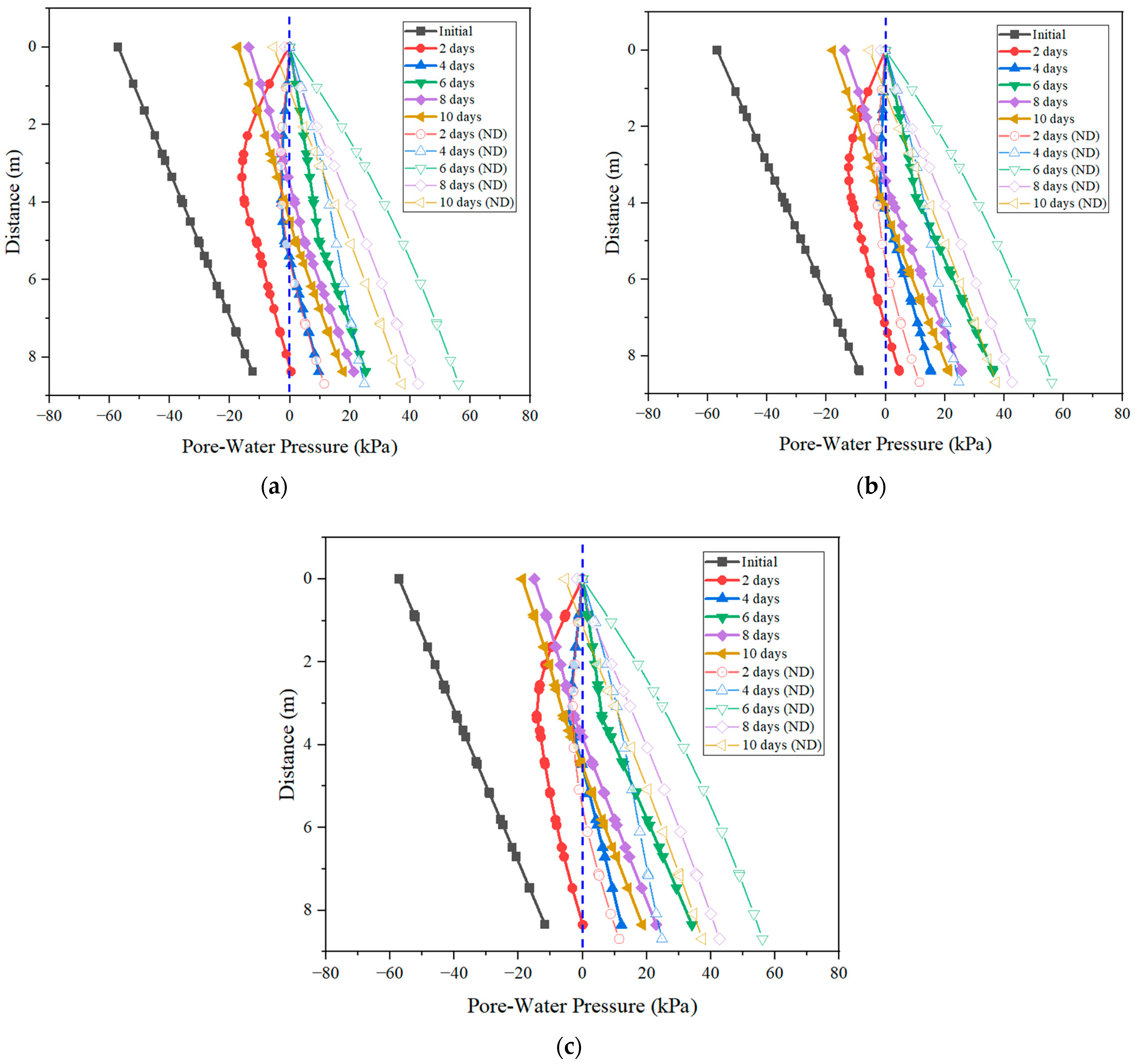
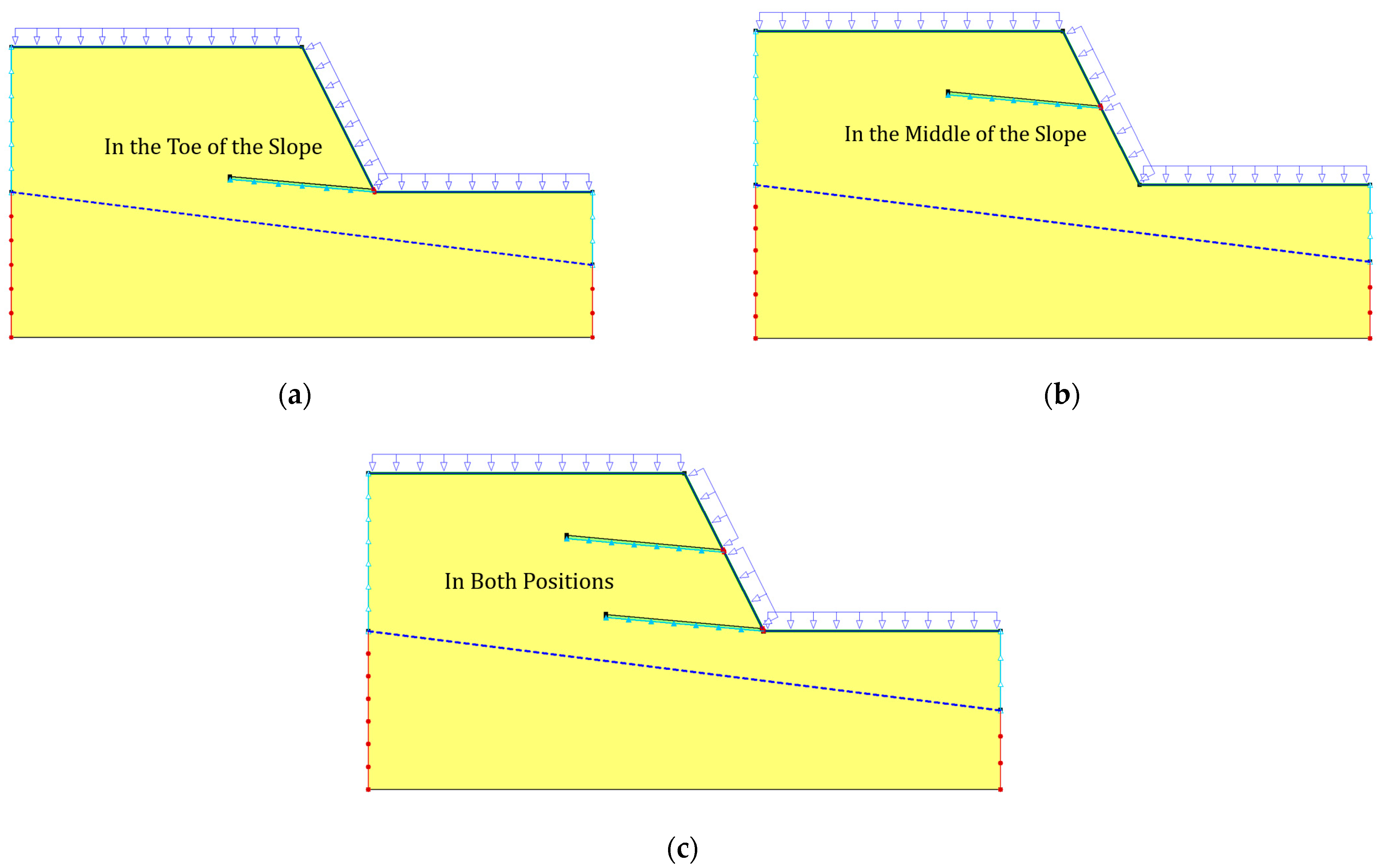
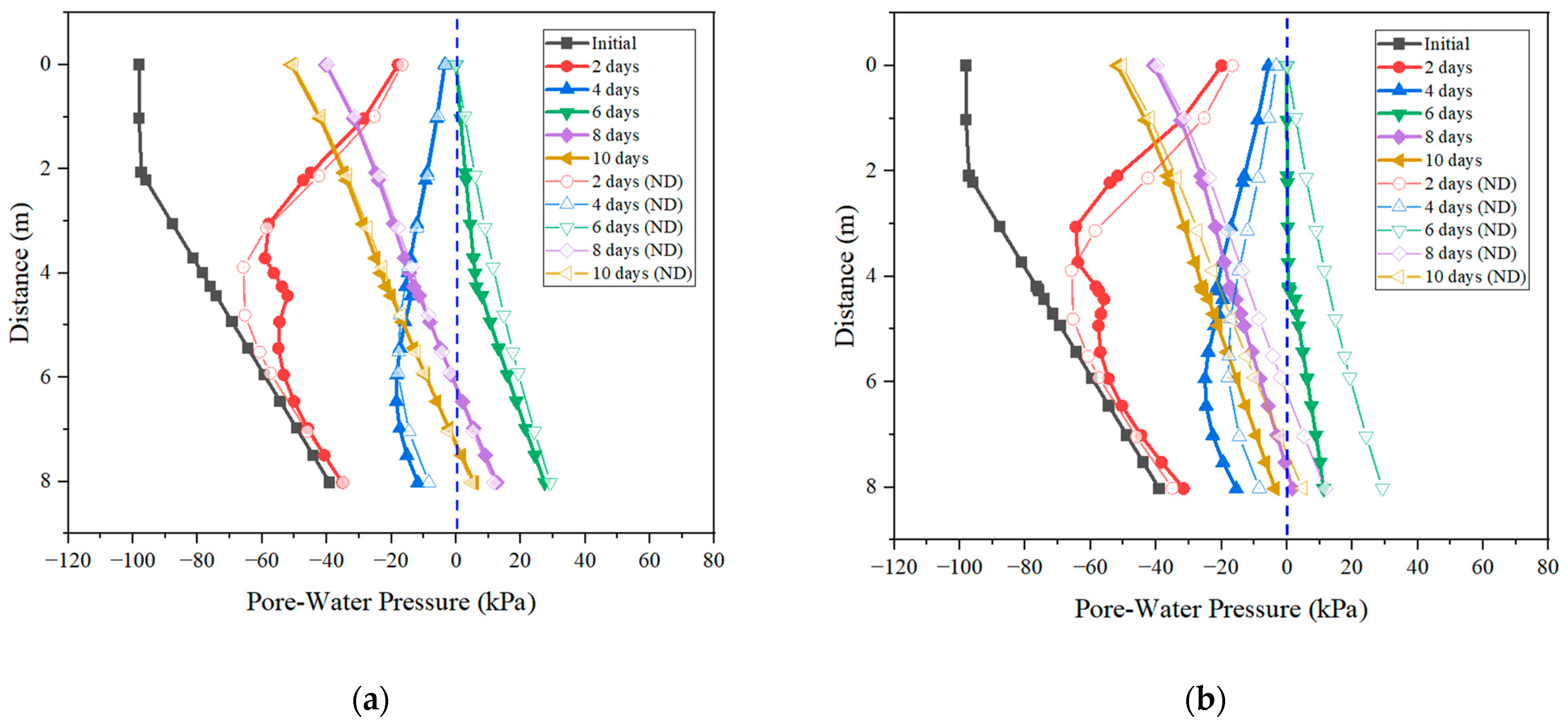
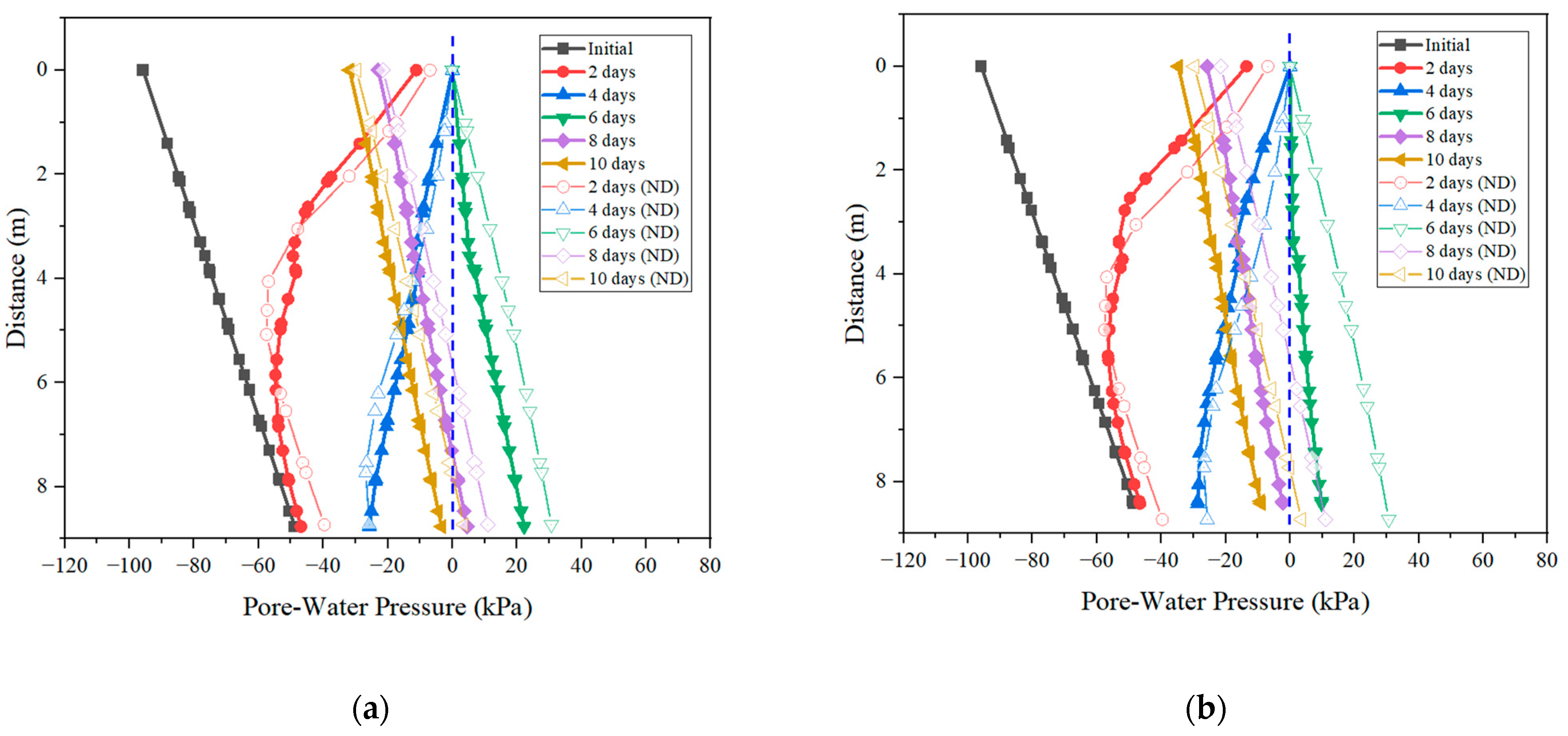

| Soil Type | SWCC Fitting Parameters | Saturated Hydraulic Conductivity | |||
|---|---|---|---|---|---|
| a (kPa) | n | m | (%) | ||
| Residual Soil | 100 | 1 | 1 | 45 | 1 × 10−6 |
| Research Plans | Horizontal Drain Layout Plan | |||
|---|---|---|---|---|
| Length (m) | Angle (°) | Location | ||
| Case 1 | Case 1-1 | 4 | 0 | Toe |
| Case 1-2 | 7 | 0 | Toe | |
| Case 1-3 | 10 | 0 | Toe | |
| Case 1-4 | 13 | 0 | Toe | |
| Case 2 | Case 2-1 | 10 | 5 | Toe |
| Case 2-2 | 10 | 10 | Toe | |
| Case 2-3 | 10 | 15 | Toe | |
| Case 3 | Case 3-1 | 10 | 5 | Toe |
| Case 3-2 | 10 | 5 | Mid-Slope | |
| Case 3-3 | 10 | 5 | Both | |
Disclaimer/Publisher’s Note: The statements, opinions and data contained in all publications are solely those of the individual author(s) and contributor(s) and not of MDPI and/or the editor(s). MDPI and/or the editor(s) disclaim responsibility for any injury to people or property resulting from any ideas, methods, instructions or products referred to in the content. |
© 2023 by the authors. Licensee MDPI, Basel, Switzerland. This article is an open access article distributed under the terms and conditions of the Creative Commons Attribution (CC BY) license (https://creativecommons.org/licenses/by/4.0/).
Share and Cite
Zhang, X.; Wang, H.; Gao, Z.; Xiang, K.; Zhai, Q.; Satyanaga, A.; Chua, Y.S. Evaluation of the Performance of the Horizontal Drain in Drainage of the Infiltrated Water from Slope Soil under Rainfall Conditions. Sustainability 2023, 15, 14163. https://doi.org/10.3390/su151914163
Zhang X, Wang H, Gao Z, Xiang K, Zhai Q, Satyanaga A, Chua YS. Evaluation of the Performance of the Horizontal Drain in Drainage of the Infiltrated Water from Slope Soil under Rainfall Conditions. Sustainability. 2023; 15(19):14163. https://doi.org/10.3390/su151914163
Chicago/Turabian StyleZhang, Xiao, Hao Wang, Zhiwei Gao, Ke Xiang, Qian Zhai, Alfrendo Satyanaga, and Yuan Shen Chua. 2023. "Evaluation of the Performance of the Horizontal Drain in Drainage of the Infiltrated Water from Slope Soil under Rainfall Conditions" Sustainability 15, no. 19: 14163. https://doi.org/10.3390/su151914163
APA StyleZhang, X., Wang, H., Gao, Z., Xiang, K., Zhai, Q., Satyanaga, A., & Chua, Y. S. (2023). Evaluation of the Performance of the Horizontal Drain in Drainage of the Infiltrated Water from Slope Soil under Rainfall Conditions. Sustainability, 15(19), 14163. https://doi.org/10.3390/su151914163









